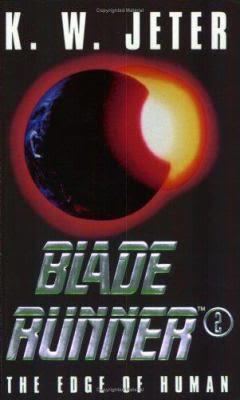6 /10 1 Votes6
Country United States Originally published 1 October 1995 Page count 340 | 3/5 Goodreads Language English Publication date October 1, 1995 | |||||||||||||||||||||||||||||||||
 | ||||||||||||||||||||||||||||||||||
Adapted from Do Androids Dream of Electric Sheep? Preceded by Do Androids Dream of Electric Sheep? Similar K W Jeter books, Science Fiction books | ||||||||||||||||||||||||||||||||||
Blade Runner 2: The Edge of Human (1995) is a science fiction novel by K. W. Jeter, and a continuation of both the film Blade Runner, and the novel upon which it was based, Philip K. Dick's Do Androids Dream of Electric Sheep?
Contents
Plot
Beginning several months after the events in Blade Runner, Deckard has retired to an isolated shack outside the city, taking the replicant Rachael with him in a Tyrell transport container, which slows down the replicant aging process. He is approached by a woman who explains she is Sarah Tyrell, niece of Eldon Tyrell, heiress to the entire Tyrell Corporation and the human template (templant) for the Rachael replicant. She asks Deckard to hunt down the "missing" sixth replicant. At the same time, the human template for Roy Batty hires Dave Holden, the blade runner attacked by Leon, to help him hunt down the man he believes is the sixth replicant - Deckard.
Deckard and Holden's investigations lead them to re-visit Sebastian, Bryant, and John Isidore (from the book Do Androids Dream Of Electric Sheep?), learning more about the nature of the blade runners and the replicants.
When Deckard, Batty, and Holden finally clash, Batty's inhuman fighting prowess leads Holden to believe he has been duped all along and that Batty is the sixth replicant; he shoots him. Deckard returns to Sarah with his suspicion: there is no sixth replicant. Sarah, speaking via a remote camera, confesses that she created and maintained the rumor herself, to deliberately discredit and eventually destroy the Tyrell Corporation, after her uncle Eldon created Rachael based on her and then abandoned the real Sarah. Sarah brings Rachael back to the Corporation building to meet with Deckard, and he escapes with her.
However, Holden - recovering from his injuries during the fight - later finds the truth: Rachael has been killed by Tyrell agents, and the "Rachael" who escaped with Deckard was actually Sarah. She has completed her revenge by both destroying Tyrell, and taking back Rachael's place.
Characters
Relationship to other works
The book's plot draws from other material related to Blade Runner in a number of ways:
However, it also contradicts material in some ways:
Reception
Michael Giltz of Entertainment Weekly gave the book a "C-", feeling that "only hardcore fans will be satisfied by this tale" and saying that Jeter's "habit of echoing dialogue and scenes from the film is annoying and begs comparisons he would do well to avoid." Tal Cohen of Tal Cohen's Bookshelf called The Edge of Human "a good book", praising Jeter's "further, and deeper, investigation of the questions Philip K. Dick originally asked", but criticized the book for its "needless grandioseness" and for "rel[ying] on Blade Runner too heavily, [as] the number of new characters introduced is extremely small..."
Ian Kaplan of BearCave.com gave the book three stars out of five, saying that while he was "not entirely satisfied" and felt that the "story tends to be shallow", "Jeter does deal with the moral dilemma of the Blade Runners who hunt down beings that are virtually human in every way." J. Patton of The Bent Cover praised Jeter for "[not] try[ing] to emulate Philip K. Dick", adding, "This book also has all the grittiness and dark edges that the movie showed off so well, along with a very fast pace that will keep you reading into the wee hours of the night."
Adaptation
It is unclear if elements of Blade Runner 2: The Edge of Human will appear in the movie sequel to Blade Runner known as Blade Runner 2049.
